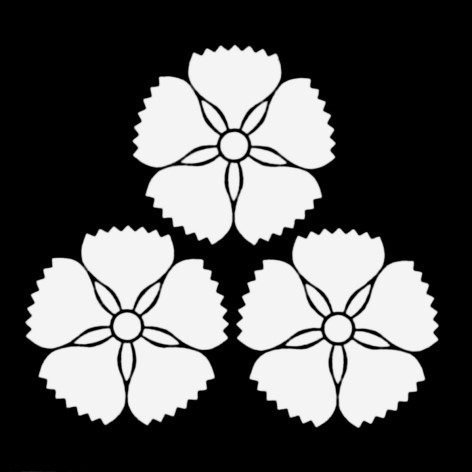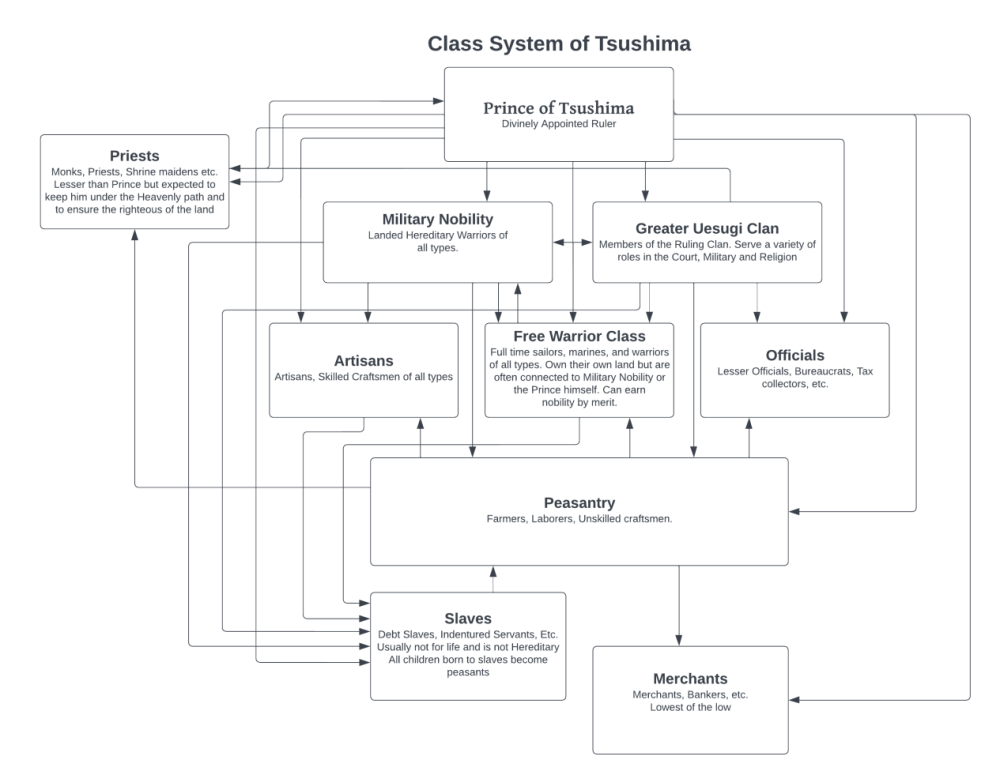Tsushima: The Emerald of the Golden Sea
The Island of Tsushima is one of the more interesting locations within the Golden Sea as a whole. The subtle oddities of the island, along with its rich history and interesting geography make it stand out and have given it is many nicknames over the years.

Geography:

The Island is a mix of flat grasslands, hill cliffs and tall mountains. Three main mountains, Mount Tsushima, Mount Yi and Mount Sasuna are the tallest peaks on the island. Mount Tsushima is a semi-dormant volcano that has unique characteristics of its own with basalt and hot springs emerging near it.
Three Rivers run across the Island, the Apo, Nagi and the Yi Rivers. Two Lakes, Lake Nagi and Lake Yi are also part of the water network.
Limestone and Marble are largely concentrated within the Mount Satsuna area, while Coal and Iron are found near the Northeastern Kojima peninsula
Places of Note:
Myeongyang:
The main city on the Island, which has an ideal harbor. It was the first major settlement on the island and is the cultural, political and economical center of the island
Uesugi Castle:
Built on the ruins of the Daemando Castle, Uesugi Castle dominates the Uesugi Peninsula as a fortification but is also a luxury estate with gardens, and pools.
Tsushima Springs
A complex built on Mount Tsushima that is a holy site on the island, as well as a tourist location.
History:
Tsushima or Daemando as it is known in Goryeon has a long history dating back to BTE times.
Early:
From its very beginning, Daemando was known to be a place of trouble. Writings found from the Kizuna Era show that Kings of Goryeo had launched many expeditions to subdue the warlike pirates that inhabited the island. In 255 BTE, the King Hyejong launched 500 warships and 50,000 against the Island to finally end the piracy haven. His plans would be foiled when the Daemando Fleet ambushed the Royal Fleet off of the small island of Jangmin, destroying most of it and sending most into flight. It would not be until the first Great King of Mujigae, Gwangjong, would finally subdue the island in 17 BTE.
Mid:
Under the Great Mujigae Kingdom, Daemando became one of the more important trade hubs in the region. It also remained a center of piracy, albeit controlled piracy that garnered it the nickname of the "Waegu Kingdom". The traditional independent spirit of the islanders led to several uprisings against the Great Kings that were all put down, except one. Which would become one of the more important events that the island experienced was the "Uesugi Revolution" of 752 VTE.
During a dynastic crisis in the Great Kingdom, a Anykarian Ronin by the name of Uesugi Akisada had made a name for himself as a great leader of men in his service to the Great King Dongmyeong. According to legend, Akisada was imprisoned by the despot king after he had married his beautiful daughter, Mano, in secret. Just before his execution, Akisada was freed by his love and fled the capital of Gunwi for their lives. Akisada was a popular man in the countryside and was able to routinely evade Royal Guards sent after him until he reached the small fishing village of Aphae, where he and his beloved set sail for Syrenia. In a great tempest, the boat was blown off course and onto Daemando. Now stranded, the Ronin received a vision from the Goddess Nagi telling him that this island, which she referred to as Tsushima was the reward for his faithful service to her over the years.
Trusting the Goddess, Akisada was able to raise a band of men that steadily grew into a small army that would defeat the Lord of Daemando at the Battle of Yesan, after which he was hailed as the Prince of Tsushima by his men. Dongmyeong was naturally not pleased and sent 3 attempts at retaking the island, resulting in failure each time. Finally in 767, the new Great King and brother of Mano, Seongmyeong met with Akisada and recognized the Ronin as the "Prince of Tsushima".
 Uesugi Clan Seal
Akisada's revolution, however, wasn't merely a change of rulers but it would have the long-term result creating a separate and unique culture and language that the Island of Tsushima would develop over time. Adventurers from the Empire of Nijisanji would venture to Tsushima over the years seeking glory under the Uesugi clan, and many would intermix with the locals to create a hybrid of the local Goryeon culture with the Anykarian culture of the adventurers. This cultural shift would also result in a language hybridization into the "Tsushimite Language".
Uesugi Clan Seal
Akisada's revolution, however, wasn't merely a change of rulers but it would have the long-term result creating a separate and unique culture and language that the Island of Tsushima would develop over time. Adventurers from the Empire of Nijisanji would venture to Tsushima over the years seeking glory under the Uesugi clan, and many would intermix with the locals to create a hybrid of the local Goryeon culture with the Anykarian culture of the adventurers. This cultural shift would also result in a language hybridization into the "Tsushimite Language".
Present:
Tsushima was barely affected by the fall of the Great Kingdom of Mujigae since its fusion of cultures and autonomy resulted in little strife. A short attempt at full independence of the Island was ended by the Imperial Navy of Nijisanji's arrival to save their former tributaries total collapse in 1046. The Prince of Tsushima, knowing full well that he could not hope to win, submitted immediately under the condition that their traditional rights would be upheld, which was agreed upon.
As of now, Tsushima is prospering under the young Prince Tsunehisa, whose great ambitions are marked equally by brilliance. Under his rule, Tsushima might soon be entering a golden age.
Culture and Society:
Government:
Tsushima is classified as an "Autonomous Feudatory Domain" officially under the Kingdom of Mujigae and is the only one place in the reformed Kingdom classified as such. Thus, Tsushima has great amounts of autonomy in its own local affairs and governance.
Furthermore, Tsushima itself represents something more akin to the Daimyos of the Empire of Nijisanji in its own governance, with the Prince of Tsushima ruling at the top with a samurai class below him. The Prince, however, does control a lot of land personally on the Island.
The Prince rules by a unique version "Heavenly Right", by which his rights as the celestial ruler of Tsushima are given that he maintains the Island's traditional rights, their unique status and promotes the Island's interest above his own. This concept was introduced under the Uesugi and thus far two rulers have been overthrown, by brothers on the appeal of the people.
The Prince of Tsushima is expected to complete a tour of the Island once a year under normal circumstances to listen and hold court for all concerns from the inhabitants of the island and arbitrate their disputes. While there is a local judicial system that usually handles such things, it is seen as part of the Celestial Duty for the Prince to intermediate on such matters himself.
All citizens of the island, regardless of class, are expected to be treated by the same rights under the law as follows:
- Right to worship the Local Deities
- Right to a fair trial and fair representation under the law
- Right to petition to Prince and receive an audience
- Right to protection from internal and external threats; and to protect thyself.
- Right to uphold the traditions of Tsushima
- Right to uphold the traditional rights of each class in fairness to even the lowest.
Some of these are rather vague to outsiders, and some might even say this is rather "enlightened" thought but these rights are well understood by the islanders and serve as the principles upon which the class system of Tsushima is founded upon. That the lowliest peasants may not be abused by even the Prince himself and that his duty shall not be infringed. Peasants are expected to be protected and honored for their role by the warriors and nobles while Peasants are expected to show the respect and honor that their overlords justly provide them. A peasant may bring a Samurai to court where the Prince may settle the matter and there have been many cases where the Peasant has been ruled to be the favorable party by the Prince.
Societal Organization:
The Organization of Tsushimite Society is a mix of Anykarian, Mujigae and Local uniqueness as shown by this chart.

Traditions:
Beyond what has already been mentioned, the Island has several traditions that separate it from the mainland.
The chief deity worshipped on the island is the Goddess Nagi, whom is the Patron Goddess of the Uesugi Clan and also the traditional Patron of the Island as well. Nagi is celebrated during the yearly pilgrimage to Mount Tsushima, where the water from the hot springs is used to clean the body and thus the soul of the pilgrim as well as the yearly "So Nagi Festival" which celebrates the Goddesses Anykarian and Goyreo heritage and thus that of Tsushima. It lasts three days starting on November 10th and ending with the Goddesses birthday of November 13th. Many fireworks, festivities, games and drinking are involved. The Prince of Tsushima himself is expected to play a vital role in closing and opening the festival by speeches he gives as Nagi's representative, and prayers offered.
Two other Goddesses, Seffyna and Hada are also celebrated greatly on the Island, Hada in particular appealing to the island due to its naval and pirate heritage. Minor festivals celebrating them are done during their birthdays.
Economy:
The Island's Economy is rather diverse despite its size.
Farming is widespread on the island and represents 1/4 of the workforce. Most of the farming is subsistence farming of staple crops like Wheat, Barley, Rye and Potatoes. The one uniquely farmed crop is the famous "Tsushimite Grapes", which are used to produce the legendary "Vintage Yeonil Wine" that the island produces. The vineyards of the Island are directly owned by the Prince and are considered somewhat sacred to the island's people given the long history and pride that comes with the wine vintage that is produced from them.
Fishing is extremely important to the island, making up 1/4 of the total workforce and provides most of the meat for the Island's population.
Mining is less frequent on the island and is largely concentrated in the north. Limestone, and Granite quarries are the most common forms of mining on the island, providing the basis for much of the Island's beautiful architecture. Deposits of Coal and Iron are also found in Kojima Peninsula, where they provide some abilities for local steel and weapon production.
Logging used to be a staple of the economy but has largely faded away as the need for trees has caused deforestation. As such, only limited operations are permitted around Mount Yi in times of need, as these trees are marked as a strategic reserve. As such, most of the lumber needed for the Island is imported or pirated.
In Myeongyang, most of the Island's manufacturing is located thanks to its importance as the Island's center of trade, commerce and shipping. The shipbuilding industry has always been a backbone of the city's economy, with all ships in the Tsushimite Navy (aside from those purchased or stolen) come from the slipways in the Grand Harbor. Most of the island's arms production comes from Myeongyang. A variety of luxury goods are also produced from imported goods in Myeongyang, including furniture, jewelry and porcelain.
In the town of Kojima, located near the coal and iron mines is the main producer of the island's steel. While the scope is rather limited, Kojimite Steel is prized locally for its quality. A number of breweries are also located in the town as well.
In the towns of Sasuna, Geojin, and Wabu which located near the major quarries, comes much of the brick production and aggregate production on the Island.
Wine Production is most famously connected with the of Yeonil, as the vintage name would suggest but is also found in Hwado, Apo and Mangyeong
Top secret, chemical plants are located in places that are withheld from public knowledge, but it is rumored that these plants produce bioweapons and "Dragon Fire".
Military:
Tsushima has a long military tradition, particularly as a naval power dating back to its foundation.
Land Forces:
The Tsushimite Army is a small but modern professional force, based on reforms undertaken 40 years before to modernize the army under Pomeranian standards with the abolition of Feudal Levies, and the complete reorganization of professional units into modern units. This professional force has 3 infantry regiments, two cavalry battalions and 6 artillery battalions, all trained and equipped for contemporary warfare.
The most important role of this standing army is the repulsion of invaders from the sea, and the construction of modern forts across the island at key points is aimed to keep landings from even happening. Modern guns and engineers from the Mononobe Shogunate have improved the islands defenses even more in recent years as well.
The island also has militia forces that can be called up at any time in dire situations.
Navy:
The Navy, of course, is Tsushima's most important guardian and weapon.
The Navy has an extremely long tradition of excellence and Tsushimite Sailors are among the best in the world by all standards. Their tactics are far from standard, as are the ships themselves.
Composition:
The Princely Fleet is rather powerful and is a mix of modern technology and Tsushimite ingenuity.
The largest and most powerful ships that the Princely Fleet has are its Great Frigates. These ships are designed to be able to be able to operate as Frigates, having the speed and manveurablity of Frigates but their hull strength and firepower rival that of smaller ships of the line. Indeed, the secret of them is the construction method, where the timbers are interlocking in the bottom of the hull.
Smaller Frigates are also part of the fleet to, and share the same design customs as their larger sisters, being able to take on larger Frigates from enemy navies while still proving to be a menace for Sloops and Brigs.
The most common ship in the Princely Fleet is the Battlesloop. A Battlesloop is a unique ship, in that it has excellent speed, manevearablity and seafaring qualities but also has powerful carronades, an Iron Ram Bow and a "Fire Thrower". Designed for brawling and bordering actions, Battlesloops should not be underestimated as enemies, as even a ship of the line can be taken out if not careful by one of these ships.
Smaller ships of all types also play their role as well as specialist ships, like Rocket Ships, Bomb Ships, Fireships and Demolition ships.
Tactics:
The Princely Navy is designed around asymmetrical naval tactics that seek to even the playing field by the unconventional way of war. Officers are encouraged to show initiative and show flexibility in their tactics.
One of the most popular tactics of the fleet is surprise attacks or attacking in many directions. Fireships and Battlesloops are sent directly at the enemy fleet while the Large Frigates, Rocket Ships and Bomb ships fire from a distance. Night Attacks are a favorite in this regard as well as is playing the tendencies of the enemy against it. Cautious enemies will be hit from all sides while aggressive enemies will be lured into traps.
The use of saboteurs and special agents against enemy facilities and ships at anchor is another favorite tactic of the fleet.